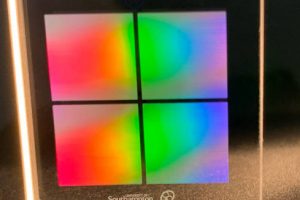Engineers at Lancaster University have transmitted, received and decoded data sent over a stream of fast neutrons. The proof-of-concept involved modulating neutrons from a calfornium 252 source using an Arduino-controlled mechanical shutter built from high-density polythene. Detection involved a one litre tank of scintillating meterial, a photo-multiplier and a ‘mixed-field analyser’ (made by Hybrid Instruments, based at the university) to separate ...
Research
The latest electronics research news from within the industry and universities from around the world.
UKRI announces Quantum computing project funding
UK Research and Innovation has announced funding for projects within the UK’s National Quantum Technologies Programme. The £50m comes from UKRI’s previously announced £170m Commercialising Quantum Technologies challenge. The projects are Aeon-Rb £2.5m Led by HCD Research to develop accurate quantum clocks for national infrastructure. Altnaharra (cryoelectronics for quantum circuits) £4.3m Led by Quantum Motion Technologies, brings together experts in: superconductivity, ion ...
Oxford Instruments partners for quantum computers
Oxford Instruments NanoScience has announced participation in three projects funded through Innovate UK’s quantum computer commercialisation program, with SEEQC, Quantum Motion and SureCore. Complete list of UK funded quantum computing projects just announced SEEQC has a £6.85m grant from Innovate UK’s Industrial Strategy Challenge Fund (ISCF) to build a commercially scalable application-specific quantum computer for Merck in Darmstadt. “By supplying its ...
DNA reveals another electronic property
Japanese researchers have added another tool to the toolbox for DNA molecular electronics. Not yet possible in any useful sense, DNA has the potential to be the backbone for molecular electronic circuits – electronics at the smallest scale – and towards this scientist are hunting through its structure and testing modifications to find useful non-linear electrical characteristics and switching behaviours. ...
Low intensity UV kills SARS-CoV-2 after a while
Osram and the University of Padua have been studying the effects of UV-C radiation from LEDs on SARS-CoV-2, the virus behind Covid-19. “It has already been shown that a high intensity of UV-C LED radiation can inactivate the SARS-CoV-2 virus rapidly,” according to the company. “In realistic applications, like upper air treatment or secondary air treatment devices [photos], the necessary dose to ...
Band engineering produces low noise avalanche photodectors
Researchers at the University of Sheffield are developing extremely low noise avalanche photodetectors using the band engineering properties of gallium arsenide bismide, says Caroline Hayes. An avalanche photodetector (APD) is able to produce large currents from the input of an extremely low light signal, down to a few photons. When a photon is absorbed, it excites an electron to the ...
Elektra 2021 – Vote for the University Research Readers’ Choice award
The readers of Electronics Weekly can decide the destination of this year’s University Research Elektra Award, which is sponsored by RS Components. The magazine’s editorial team has selected six research projects from the last year as the shortlist and you are invited to vote for the one you think will make the largest impact on the commercial market in the next ...
Updated: 500 terabytes of data on a CD, almost
The University of Southampton is storing data onto glass at a density that would squeeze 500Tbyte onto a substrate the size of a CD. Data is written as miniature shapes through the bulk of silica glass using the three spatial dimensions. The shapes have two separate optical characteristics – adding two more dimensions – making this so-called five-dimensional (‘5d’) data storage. ...
Apple joins Imec’s Sustainable Technologies initiative
Apple has joined Imec’s new Sustainable Semiconductor Technologies and Systems (SSTS) research program. The SSTS program is the first initiative rallying stakeholders from across the IC value chain to anticipate the environmental impact of choices made at chip technology’s definition phase. Using concrete and reliable models, and detailed (carbon) footprint analyses, the program will help the IC-making industry cut back ...
Glassification could stabilise Perovskite light emitters
Lead (Pb) halide perovskites, known for fledgling solar cell technology, can also emit light. The materials are generally unstable in the moisture of the atmosphere, deteriorating over hours or days. But researchers in Australia have maintained ~80% of emission despite 10,000 hours of water immersion. Although this was a photo-luminescence proof-of-concept – emitting light when illuminated by a laser in ...
 Electronics Weekly Electronics Design & Components Tech News
Electronics Weekly Electronics Design & Components Tech News


